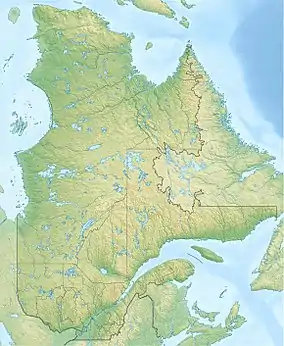| Saint-Étienne River | |
|---|---|
 | |
| Native name | Rivière Saint-Étienne (French) |
| Location | |
| Country | Canada |
| Province | Quebec |
| Region | Saguenay-Lac-Saint-Jean |
| Regional County Municipality | Le Fjord-du-Saguenay Regional County Municipality |
| Municipalities | Petit-Saguenay and Baie-Sainte-Catherine |
| Physical characteristics | |
| Source | Lake Ovila-Lavoie |
| • location | Petit-Saguenay |
| • coordinates | 48°10′29″N 69°56′41″W / 48.17465°N 69.94485°W |
| • elevation | 132 m (433 ft) |
| Mouth | Saguenay River |
• location | Petit-Saguenay |
• coordinates | 48°12′02″N 69°54′53″W / 48.20055°N 69.91472°W |
• elevation | 3 m (9.8 ft) |
| Length | 4.8 km (3.0 mi)[1] |
| Discharge | |
| • location | Baie-Sainte-Catherine |
| Basin features | |
| Tributaries | |
| • left | Décharge du lac Fidelin. |
| • right | Embranchement Gagnon. |
The Saint-Étienne River is a tributary of the south shore of the Saguenay River flowing into the municipality of Petit-Saguenay in the Saguenay Fjord, Quebec, Canada. In the end, this river crosses the Saguenay Fjord National Park.
The Saint-Étienne River Valley is mainly served by Chemin Saint-Étienne and Chemin du Lac Fidelin.[2][3]
Forestry is the first economic activity in the sector; recreational tourism activities, second.
The surface of the Saint-Étienne River is usually frozen from the beginning of December to the end of March, however, safe ice circulation is generally from mid-December to mid-March.
Geography
The main hydrographic slopes near the Saint-Étienne River are:
- North side: Saguenay River;
- East side: Petites Îles River, St. Lawrence River;
- South side: Petit Saguenay River;
- West side: Petit Saguenay River, Cabanage River.
The Saint-Étienne River rises at the mouth of Lac des Côtes (length: 0.6 km (0.37 mi); altitude: 132 m (433 ft)). This source is located at: 3.8 km (2.4 mi) south of its mouth (confluence with the Saguenay River); 7.4 km (4.6 mi) northeast of a curve of the Petit Saguenay River; 18.0 km (11.2 mi) west of the mouth of the Saguenay River; 10.2 km (6.3 mi) south-east of the village center of Petit-Saguenay.
From its source (Lac des Côtes), the course of the Saint-Étienne River descends on 4.8 km (3.0 mi) according to the following segments: 2.9 km (1.8 mi) northerly in a confined valley to the outlet (from the southeast) of an unidentified lake; 1.5 km (0.93 mi) northerly in a concealed valley to the outlet (coming from the west) of Lac Fidelin; 0.4 km (0.25 mi) blaster in a valley through Saguenay Fjord National Park to its mouth.[4]
The mouth of the Saint-Étienne River flows into the bottom of Anse Saint-Étienne on the south shore of the Saguenay River. This confluence is located at:
- 3.6 km (2.2 mi) north-east of the village center of Saint-Étienne;
- 14.4 km (8.9 mi)} east of the confluence of the Petit Saguenay River with the Saguenay River;
- 17.0 km (10.6 mi) west of Tadoussac.
Toponymy
The toponym "Saint-Étienne River" refers to St. Stephen (French: Saint-Étienne), a patron of the Roman Catholic Church.
The toponym "Saint-Étienne River" was formalized on December 5, 1968, at the Bank of Place Names of the Commission de toponymie du Québec.[2]
Notes and references
- ↑ "Rivière Saint-Étienne, Bank of Quebec place names". Commission de toponymie du Québec. Retrieved December 9, 2019.
- 1 2 "Rivière Saint-Étienne (Saint-Étienne River)". Commission de Toponymie du Québec. Bank of Quebec place names.
- ↑ Open Street Map - Retrieved December 9, 2019
- ↑ "Atlas of Canada from the Department of Natural Resources Canada". 12 September 2016.
External links
See also
- Petit-Saguenay, a municipality
- Saguenay Fjord National Park
- Saguenay River, a watercourse
- List of rivers of Quebec